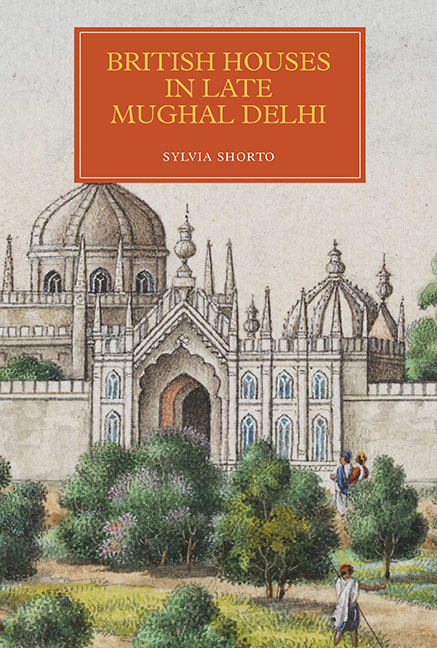Book contents
- Frontmatter
- Dedication
- Contents
- List of Illustrations
- Preface and Acknowledgements
- Abbreviations
- Glossary
- Map
- Chapter 1 Knowledge of Delhi: The Eighteenth Century
- Chapter 2 Hybrid Accommodations: David Ochterlony, the First Residency and the Mubarak Bagh
- Chapter 3 A Lovely Wilderness: Charles Metcalfe and the Garden Houses at Shalimar
- Chapter 4 Truly Fairy Palaces: Robert Smith in Delhi and in Europe
- Chapter 5 The World Displayed: William Fraser and his House on the Hill
- Chapter 6 A Tomb with View: Thomas Theophilus Metcalfe's Dilkusha
- Chapter 7 Dreaming of Home
- Bibliography
- Index
- Miscellaneous Endmatter
Chapter 5 - The World Displayed: William Fraser and his House on the Hill
Published online by Cambridge University Press: 07 July 2018
- Frontmatter
- Dedication
- Contents
- List of Illustrations
- Preface and Acknowledgements
- Abbreviations
- Glossary
- Map
- Chapter 1 Knowledge of Delhi: The Eighteenth Century
- Chapter 2 Hybrid Accommodations: David Ochterlony, the First Residency and the Mubarak Bagh
- Chapter 3 A Lovely Wilderness: Charles Metcalfe and the Garden Houses at Shalimar
- Chapter 4 Truly Fairy Palaces: Robert Smith in Delhi and in Europe
- Chapter 5 The World Displayed: William Fraser and his House on the Hill
- Chapter 6 A Tomb with View: Thomas Theophilus Metcalfe's Dilkusha
- Chapter 7 Dreaming of Home
- Bibliography
- Index
- Miscellaneous Endmatter
Summary
This chapter presents new information on British suburban expansion in Delhi, shown through the life and building activities of another East India Company official, William Fraser (1784–1835). In the chapter, I compare two newly built houses in expanding British suburban enclaves to the north and west of the walls of Shahjahanabad: the Gothicising Ludlow Castle in the Civil Lines, built a decade earlier but used after 1832 by Fraser and his successors as the Residency building; and the strategically located hilltop house that Fraser built for himself on the Northern Ridge which, through its symbolic location, linked India's resonant pre-Mughal past with a British present. Though they were stylistically quite different and situated several miles apart, these houses and the dates of their construction have been muddled in the secondary literature. I will try to disentangle the evidence for their histories. At first glance, each house seems to reflect an adaptation, in Delhi, of the two currently competing historic style vocabularies in European architecture: the classical and the Gothic. But when more closely examined they tell us about the disorderly layers of transculturation in Delhi. British builders now commonly drew on the functional aspects of north Indian architecture to help deal with the searing heat of the early summers. Yet the exterior style of a British house did not necessarily reflect its interior configuration and certainly not its contents. The objects contained within the households of William Fraser had multiple meanings, and his collections are a clue to his contradictory personality.
Within a very few years of their arrival in Delhi, the British had begun to erect new dwellings outside the fortified walls of Shahjahanabad. The Maratha invasions and periodic raids by displaced Gujjar tribesmen who had lost lands to the north of the city had been quelled, and the hinterland was becoming safer. The environment inside the city walls had always presented paradoxes that some British officials could not reconcile with what they knew of life on large estates in the Indian countryside.
- Type
- Chapter
- Information
- British Houses in Late Mughal Delhi , pp. 111 - 138Publisher: Boydell & BrewerPrint publication year: 2018

